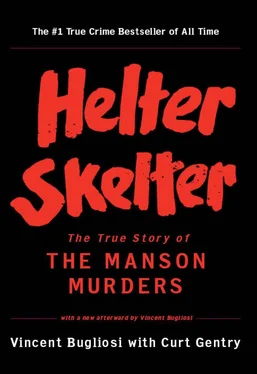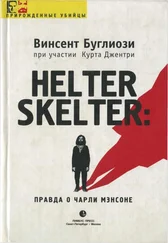In a long, typewritten letter to me on May 11, 1994, Atkins wrote: “Twenty-five years ago you tried three girls between the ages of twenty and twenty-two years old, and one thirty-five-year-old ex-con. Now, twenty-five years later, there are three women about the age of forty-five, all of whom have exemplary prison records, have taken advantage of the educational programs to earn college degrees, have contributed to every charity organization and program available, and have expressed remorse, shame, and regret for their parts in this hideous crime…and you have one sixty-year-old ex-con who shows up at his parole board hearings with a swastika carved on his forehead. I think that says it all.”
Though Atkins is very critical of Manson, she has said she still prays for him, “that Charlie will turn to Christ.” Atkins has obtained, through correspondence, an Associate of Arts degree (two years), graduating with a 3.5 grade point average. She also has completed a course in vocational data processing, and is presently taking paralegal classes. Her current work assignment at Frontera is that of a sewing operator in the Prison Industries program.
In 1976, Leslie Van Houten’s conviction for the two LaBianca murders was reversed and sent back for a new trial by the California Court of Appeal, Second Appellate District, on the ground that Judge Charles Older had erred in not granting her motion for a mistrial when her attorney, Ronald Hughes, vanished near the end of the trial. After a hung jury in the first retrial, she was finally reconvicted of the two murders in 1978. As opposed to the guilt phase of her original trial back in 1970–71, in her two retrials Van Houten readily admitted to the jury her full participation in the LaBianca homicides. Her defense was diminished mental capacity based on mental illness induced, in part, by the chronic, prolonged use of hallucinogenic drugs. For a few months before her last trial she was released on a $200,000 bail bond paid for by friends and relatives, and lived for a while with a former writer from the Christian Science Monitor who was writing a book about Van Houten. The book reached the first draft level, but was never published.
Van Houten had a short-lived marriage to a man named Bill Cywin in the early ’80s. Though not connected to any misbehavior or complicity on her part, during the brief marriage Cywin was found to be in possession of a female prison guard’s uniform.
Through correspondence courses, Van Houten acquired a Bachelor of Arts degree in English Literature. She also writes short stories, one of which was included in an anthology of prison literature, and at one time edited the prison newspaper. She is part of a small inmate group that sews quilts for the homeless. Van Houten says she “takes offense to the fact that Manson doesn’t own up” to his responsibility for the murders. “I take responsibility for my part, and part of my responsibility was helping to create him. Being a follower does not excuse.” Van Houten is presently doing secretarial work at the prison.
Patricia Krenwinkel received a Bachelor of Science degree through correspondence while at Frontera and has also completed a course in vocational data processing. Krenwinkel has never married. The most athletic of the three Manson girls, she plays on the prison softball team and presently is a “camp trainer” in the inmate firefighter’s program, training those under her to meet a physical fitness standard they must have in order to fight fires. Both she and Van Houten serve as counselors in a program in which young people with drug abuse problems are brought to the prison.
In 1988, while stating her deep remorse for the murders, Krenwinkel nonetheless told her prison psychiatrist that Abigail Folger, the person she murdered on the night of the Tate murders, “could have been something more than she was, a drug abuser.” At her 1993 parole hearing, Krenwinkel, crying and her voice cracking, told the board: “No matter what I do, I cannot change one minute of my life. There’s nothing I can do outside of being dead to pay for this. And I know that’s what you wish, but I cannot take my own life.” In the 1994 ABC special, she said that every day “I wake up and know that I’m a destroyer of the most precious thing, which is life, and living with that is the most difficult thing of all.” But, she adds, “that’s what I deserve—to wake up every morning and know that.” Responding to Manson’s claim he did not order the murders, she said, “Charlie is absolutely lying. There wasn’t one thing done—that was even allowed to be done—without his express permission.” She is very concerned about young people who write her and “seem to think that what we did was all right. There is nothing, nothing that we did that is all right. If there is anything I can say to these children, it’s that he [Manson] is not the man to follow.”
All other family members convicted of Manson-related murders, with the exception of one, are also still behind bars. Bruce Davis, convicted of the murders of Donald “Shorty” Shea and Gary Hinman, is presently at the California Men’s Colony at San Luis Obispo, California, and Robert Beausoleil, also convicted of the Hinman murder, is at the California Correctional Center at Susanville, California. Only Steven Grogan (“Clem Tufts” in the Family), convicted of Shea’s murder, has been released.
Grogan was by all accounts the most unhinged and spaced out (on psychedelic drugs) of all Manson Family members. Even in the Family he was considered crazy. Yet the transformation behind bars for Grogan, eighteen years old at the time he participated in Shea’s murder, was remarkable. Burt Katz, who prosecuted Grogan, and is now a retired Los Angeles County Superior Court judge, says he was “favorably impressed” by the change in the openly remorseful Grogan, and felt he had matured into “a thoughtful, sensitive young man.” Sergeant William Gleason of the Los Angeles County Sheriff’s Department, a lead investigator in the Shea murder, was similarly impressed, calling the change in Grogan “amazing.” Grogan became very adept behind bars at painting watercolors and playing his guitar, and obtained an airplane engine mechanic’s license.
One of the enduring Manson Family mysteries was cleared up by Grogan. It had become part of Manson Family lore, possibly to frighten all members who had a mutinous thought, that Shea was decapitated by Grogan and had been cut up and buried in nine separate places at Spahn Ranch. However, extensive digging at the ranch by law enforcement had failed to uncover Shea or any part of him. In 1977, Grogan, while at the Deuel Vocational Institution at Tracy, California, asked to see Katz. Determined to prove he had not beheaded Shea, and that Shea had not been cut up into nine pieces, he drew a map for Katz, pinpointing the location of Shea’s body. Subsequently, Sergeant Gleason and his partner found Shea’s remains in one piece at the spot designated by Grogan—the bottom of a steep embankment about a quarter mile down the road from the ranch. On November 18, 1985, Grogan was released from prison, and was discharged from parole on April 13, 1988.
Although Manson, today, has far more supporters and sympathizers than ever were members of his Family, I know of no group at the present time, in or out of prison, calling themselves the Manson Family and trying to keep the flame alive. The nomadic band of minstrels, waifs, and latent killers he assembled around him in the late ’60s is no more, and no new group has emerged to take their place. With two exceptions, all of his former followers have severed their umbilical cord to him, starting new lives. Only Squeaky and Sandra (“Red” and “Blue,” Manson calls them), their faces still suffused with a missionary glow, have remained irrevocably wedded to him, and still fervently preach his gospel.
Читать дальше












